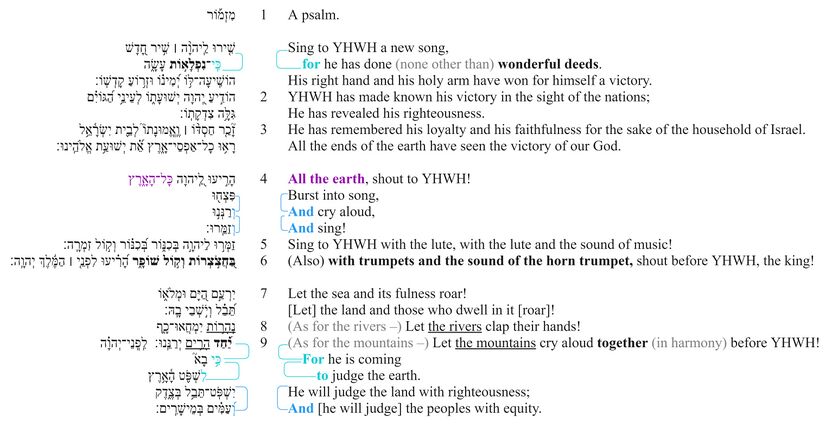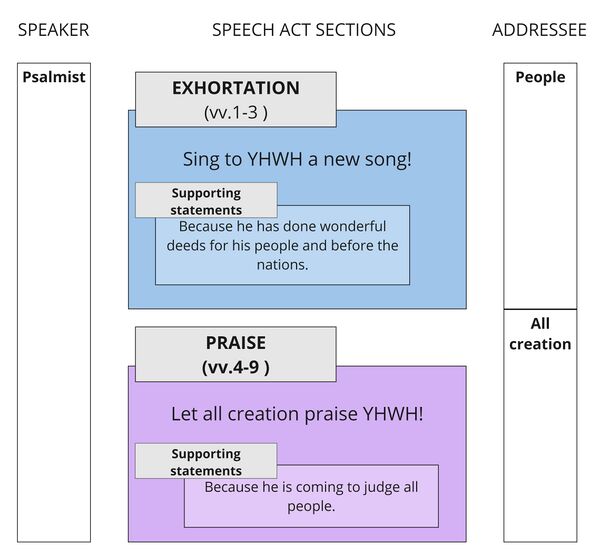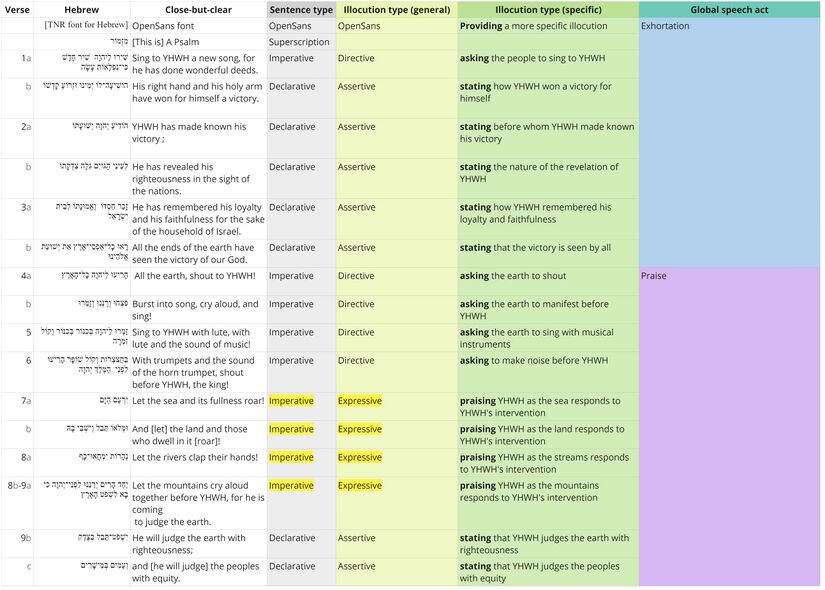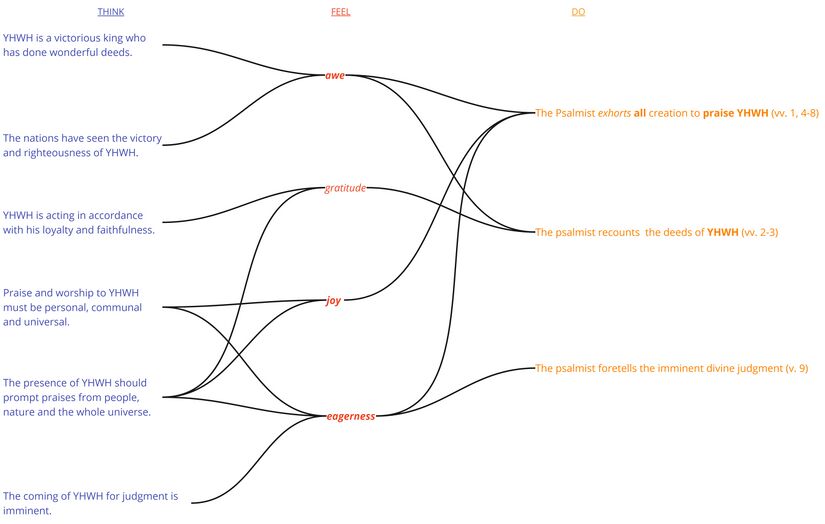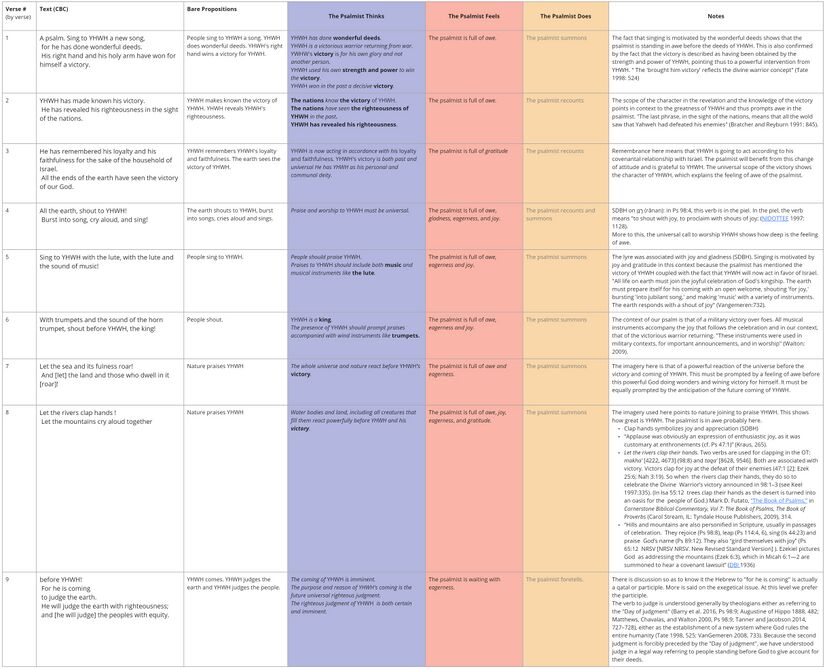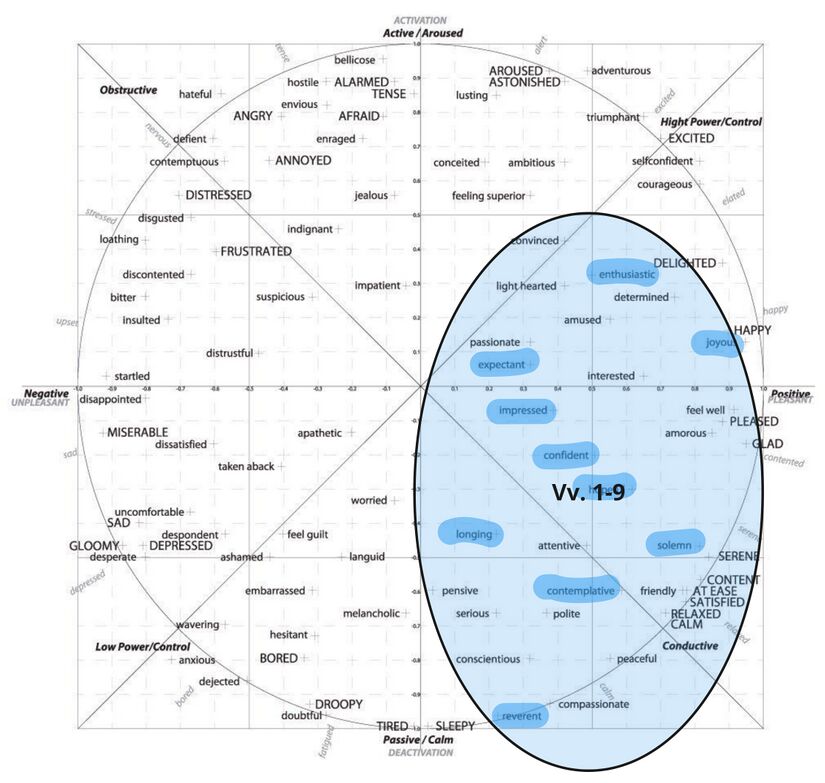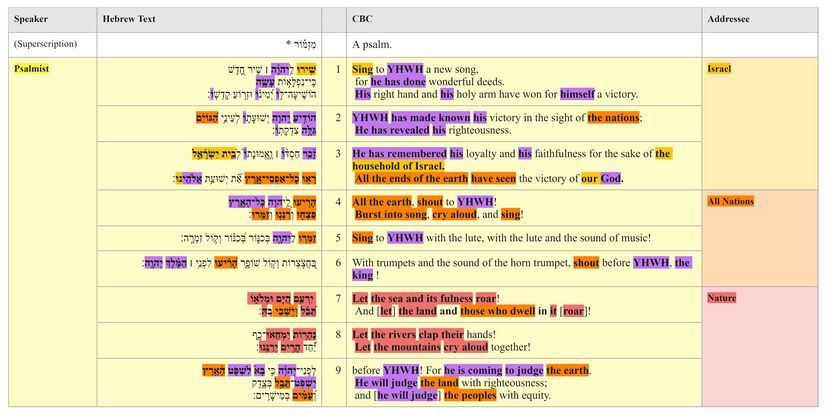Psalm 98 Discourse
About the Discourse Layer
Our Discourse layer includes four analyses: macrosyntax, speech act analysis, emotional analysis, and participant analysis. (For more information, click 'Expand' to the right.)
Macrosyntax
The macrosyntax layer rests on the belief that human communicators desire their addressees to receive a coherent picture of their message and will cooperatively provide clues to lead the addressee into a correct understanding. So, in the case of macrosyntax of the Psalms, the psalmist has explicitly left syntactic clues for the reader regarding the discourse structure of the entire psalm. Here we aim to account for the function of these elements, including the identification of conjunctions which either coordinate or subordinate entire clauses (as the analysis of coordinated individual phrases is carried out at the phrase-level semantics layer), vocatives, other discourse markers, direct speech, and clausal word order.
For a detailed explanation of our method, see the Macrosyntax Creator Guidelines.
Speech Act Analysis
The Speech Act layer presents the text in terms of what it does, following the findings of Speech Act Theory. It builds on the recognition that there is more to communication than the exchange of propositions. Speech act analysis is particularly important when communicating cross-culturally, and lack of understanding can lead to serious misunderstandings, since the ways languages and cultures perform speech acts varies widely.
For a detailed explanation of our method, see the Speech Act Analysis Creator Guidelines.
Emotional Analysis
This layer explores the emotional dimension of the biblical text and seeks to uncover the clues within the text itself that are part of the communicative intent of its author. The goal of this analysis is to chart the basic emotional tone and/or progression of the psalm.
For a detailed explanation of our method, see the Emotional Analysis Creator Guidelines.
Participant Analysis
Participant Analysis focuses on the characters in the psalm and asks, “Who are the main participants (or characters) in this psalm, and what are they saying or doing? It is often helpful for understanding literary structure, speaker identification, etc.
For a detailed explanation of our method, see the Participant Analysis Creator Guidelines.
Discourse Visuals for Psalm 98
Macrosyntax
Notes
Paragraph Divisions
- Delimitation (vv. 3-4)
- v. 4a - the phrase "כָּל־הָאָ֑רֶץ" is focused.
- v. 3b, 4a - there is a shift with the subject.
- vv. 1-3, 4-6 - we go from qatal verbs to imperatives.
- Delimitation (vv 6-7)
- v. 6, 7a - the shift with the subjects shows a break.
- vv. 4-6, 7-9a - The imperative verbs are followed by jussive/yiqtol verbs (vv. 4-6, 7-9a) pointing to a paragraph delimitation.
Word Order
- v. 1a - "the wonderful deeds", the direct object of the verb "to do" is fronted and thus focused here.
- v. 6 - the fronting of the adverbial phrase "בַּ֭חֲצֹ֣צְרוֹת וְק֣וֹל שׁוֹפָ֑ר" shows that this information is focussed.
- v. 8b - יַ֝֗חַד is focus, since הָרִ֥ים is clearly in parallel topic position to נְהָר֥וֹת. We have thus focus + topic + verb, filling the presupposition “The mountains will shout in X manner”, where X = together.
- v. 8-9 - Two marked topics, "the rivers" and "the mountains" which are fronted. There is something unexpected happening in both clauses with an emphasis on both topics.
Vocatives
- v. 4a - the vocative "כָּל־הָאָ֑רֶץ" is clause-final, dividing the clause of v. 4a from the following three imperatives.
Conjunctions
- v. 1b - the conjunction כִּ֥י introduces a subordinate causal clause (v. 1b). Because v. 1b is a summary of YHWH's intervention in history, the conjunction is limited to v. 1b.
- v. 4 - The series of three imperatives are linked by two waws to create a synonymic unit semantically, syntactically, and morphologically. They form a strong unit, almost a slowing process most certainly for emphasis.
- v. 7 - despite the absence of a conjunction between the first two clauses, the verb implied in the second shows that there are conjoined. . At the semantic level, both clauses carry the same images of nature roaring as a way to celebrate YHWH.
- v. 9b - the conjunction כִּ֥י introduces a subordinate causal clause which gives the reasons for the preceding imperatives and jussives of vv. 4-8 and less probably for v. 8b.
- v. 9c - the purpose/result infinitive construct (לִשְׁפֹּ֪ט) gives the reason for YHWH’s action.
- v. 9d, e - the waw operates at the clausal level and creates two independent clauses with an elided verb. The two actions of the verbs are at most simultaneous or less synonymic as one may expect in poetry.
Speech Act Analysis
Summary Visual
Speech Act Chart
Notes
- The MT text of Psalm does not provide an explicit identity about the author of the Psalm. Some ancient witness like the LXX adds "of David" thus providing an explicite Davidic link with the Psalm.
- The text of the Psalm also does not give an explicit addressee. We only know that the psalmist is addressing a group of people whom he identifies as sharing the same God. We see this in verse 1, where the verb sing is plural and in verse 3 where the psalmist mentions "our God" in reference to YHWH.
- Notes on the illocution type of verses 7a-9a:
- Determining the sentence type of those verses is a challenge because they can be a jussive or a yiqtol.
- If we are dealing with a yiqtol, the illocution type should be assertive. But because we have favored a jussive in our context, the illocution type is "Expressive". The author of the Psalm is expressing his emotions by appealing to a very strong image of nature manifesting before YHWH. The emotion here is that of praise.
Emotional Analysis
Summary visual
Emotional Analysis Chart
Emotional Circumplex
Participant analysis
There are 5 participants/characters in Psalm 98:
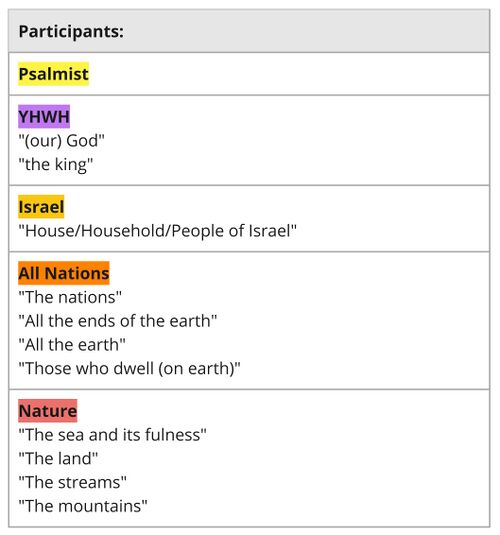
- There is no clear reference to the identity of the psalmist in some ancient texts like the Massoretic. Nonetheless, it is possible that the psalmist is David as suggest other ancient texts like the LXX.
- YHWH is portrayed in the Psalm like a victorious king coming from war against his people's foes. He is also presented as the universal and righteous judge who is to be praised by all.
- Vv. 1-3 call on an unspecified people to “sing to YHWH a new song”. This most likely addresses the people of Israel, who are the primary audience of the psalm. For further details see the participant tracking notes.
- The nations can be understood first as non-Israelite people groups. As we have it on our participant analysis notes, the earth refers most certainly to all humanity.
Participant Relations Diagram
The relationships among the participants may be abstracted and summarized as follows:
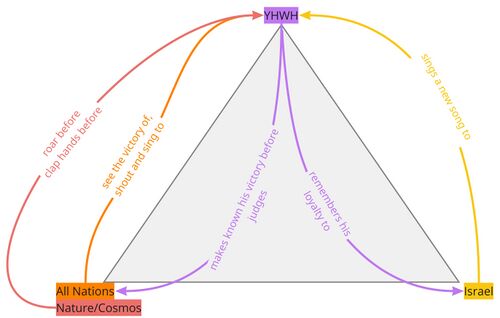

Participant Analysis Table
Notes
- Vv. 1-9: Who is the general addressee of our psalm?
- On the one hand, the psalm may be addressed to Israel, with references, for example, to "our God" (v. 3) and a celebration of God's faithfulness to Israel (v. 3).
- On the other hand, the Psalm seem to have a universal scope, thus favoring the addressee to be mankind in general. We can see "the nations" in verse 3, "the ends of the earth" of verses 3-4, the whole creation in verses 4-9 called with vivid imperatives (Stream 2008: Ps 98.4–6). Moreover, YHWH is presented as the universal king and judge in verse 9.
- We prefer to see the general addressee as the people of Israel, with all nations and nature as secondary addressees.
- v. 1: Is the psalmist mentioned in the superscript David?
- There is disagreement among ancient witnesses on the superscript. Some simply omits the name of David and have only "a psalm." This is the case of MT. On the other hand some witnesses like the LXX adds "of David" to the superscript, thus establishing a Davidic tie to the Psalm (Tate 1998:523).
- Argument in favor of David as the psalmist: A witness like the LXX might be depending on a manuscript older and more reliable than the one used by the MT. Also the background of the Psalm is pre-Davidic, especially as referring to event such as Exodus from Egypt.
- Argument against David as the psalmist: The addition "of David" is explained as harmonisation with other Davidic psalms. The back-ground of the Psalm is post-exilic as Israel commemorate their return from Babylon. The use of the expression "before YHWH" seems to favor the setting of the Temple.
- We have followed the MT text because a later addition is better explained as a scribal harmonization and/or explicitation less than an omission.
- v. 2: How should we understand "nations" here, any group of people or non-Israelite nations?
- The nations may refer to large body of people or often to the non-Israelite nations, especially when used in plural (SDBH). The word being plural here, we prefer this second option because ""gôyim usually refers to nations, especially the surrounding pagan nations" (1999). 326 גוה. TWOT.
- Vv. 1-3: Who are the people addressed in verse 1, mankind in general or Israel?
- The Psalm begins with the imperative שִׁ֤ירוּ with no further explicite indications about the identity of the addressees of the Psalm. We need to depend on the context to determine the addressee.
- The Psalmist gives a probable hint when in verse 3 talking about "our God". This exclusive presentation of YHWH shows that the people addressed is "Israel". Furthermore, the people of Israel is explicitly mentioned in verse 3 where God is acting in accordance to his loyalty and faithfulness in favor of Israel.
- Vv. 3-4: Is the expression "all the earth" interpreted literally or not?
- The expression is metaphorical because the imperatives of vv. 4-6 require volitional beings as subjects of the verbs.
- The expression is both a metonymy referring to all mankind (all nations) and humanity independently of the area of the earth they inhabit (Crossway Bibles 2008: 1062).
- "The expression all the earth must often be rendered as 'all people everywhere' or 'all people living on the earth'" (Bratcher and Reyburn 1991: 846).
- Vv. 5-6: Who is singing and making noise? the people, the earth or nature?
- Many commentaries see "all the earth" as the addressee of the imperatives of verses 5-6 (See Crossway Bibles 2008:1062 and Stream 2008: Ps 98.4–6). The Hebrew text however does not provide an explicit subject to the imperatives and we must ask ourselves who is singing and making noise. We have three options.
- the people (of Israel) addressed in vv. 1-3. This option is less probable because our imperative start after a shift in addressee has happened in verse 4.
- Nature is addressed in vv. 7-9. This option is also less possible because it implies that the subject of the imperatives is introduced after the verbs themselves.
- All the Earth (all nations) of vv. 3-4, 9: This is our preferred option for the reason that it is the last addressee before the imperatives of verses 5-6. They are simply elided.
- Vv. 7-8: Who is in view nature or cosmos?
- Verses 7-8 obviously use personification and present a response from the elements of the non-human created order.
- Commentaries disagree here and we have three main views. (1) "Nature", as the environment where man lives (see McNeile 1942: 366, VanGemeren 2008:733, Matthews, Chavalas and Walton 2000: Ps. 98:8, Keil and Delitzsch 1996: 630, Tate 1998: 525, Kidner 1975: 386).
- Other commentaries hold to (2) cosmos as the whole non human creation here (see Carson 2018:993, Tanner and Jacobson 2014: 727, New Living Translation Study Bible 2008: Ps. 98:7-9, Bratcher and Reyburn 1991: 847, Jamieson, Fausset and Brown 1997: 375 ).
- Finally some commentaries think that nature and cosmos are both in view here especially because both fit well in this context (see Prinsloo 2003: 412 and La Bible Expliquée 2004: 831).
- All these options are viable but we have preferred to the nature here because the text does not explicitly mentions some other aspects of creation/cosmos such as the heavens, the skies and the stars, and the merism language "heavens and earth" as we can see in the creation story of Genesis. On the other way, the elements cited here are clearly part of nature.
- v. 9: To what refers the earth, the land and the peoples?
- The verb to judge requires a volitional being for its subjects. "The earth", "the land" are used metaphorically here. We have a personification (Stream 2008: Ps 98.7–9).
- The definite articles of the two words show that the psalmist has a particular group in mind.
- "The 'earth' signifies here the inhabitants of the earth" (VanGemeren 2008:732).
- Both the Hebrew words for The earth' and "the land" appear together with the meaning of the world: 1Sam 2:8: land/world and earth, Job 34:13, Ps 19:5
- The people is plural in the Hebrew and most certainly refers to nations as groups.
